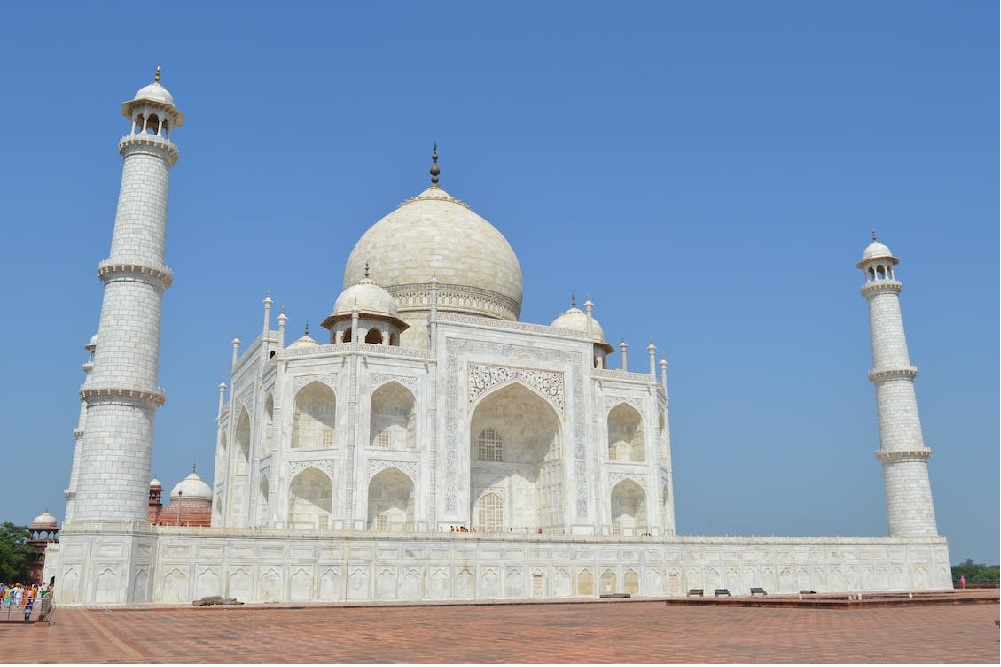The Taj Mahal: An Eternal Ode to Love and Architecture (500 words Essay – Sample – 1)
The Taj Mahal, an exquisite marble mausoleum located in Agra, India, is not just a monument; it’s a masterpiece that embodies the essence of love, architecture, and cultural heritage. Commissioned by the Mughal Emperor Shah Jahan in memory of his beloved wife Mumtaz Mahal, this awe-inspiring structure has captured the world’s imagination for centuries.
Construction of the Taj Mahal began in 1631 and took approximately 22 years to complete. The monument’s flawless architecture is a harmonious blend of Persian, Islamic, and Indian styles, reflecting the multicultural influences of the Mughal era. The pristine white marble façade, adorned with intricate carvings and precious gemstones, is a testament to the exceptional craftsmanship of skilled artisans.
The Taj Mahal complex comprises several key elements, each contributing to its grandeur and significance. The main mausoleum, housing the tombs of Shah Jahan and Mumtaz Mahal, is surrounded by symmetrical gardens, reflecting pools, and elegant minarets. The meticulous alignment of these elements creates a visual masterpiece that evokes a sense of serenity and awe.
The Taj Mahal’s allure is most enchanting during sunrise and sunset when the changing hues of the sky cast a soft, golden glow upon the marble surface. As the sun’s rays play upon the intricate patterns and designs, the monument appears to change color, creating a surreal and ethereal ambiance.
Beyond its visual beauty, the Taj Mahal carries profound historical and cultural significance. It serves as a testament to the grandeur and opulence of the Mughal Empire under Shah Jahan’s rule. The monument also stands as a symbol of eternal love, immortalizing the deep affection Shah Jahan held for Mumtaz Mahal. This symbolism is reflected in the meticulous design, where every aspect of the Taj Mahal conveys a sense of unity and eternity.
In recognition of its outstanding value, the Taj Mahal was designated as a UNESCO World Heritage Site in 1983. However, this architectural marvel faces challenges in the modern world. Pollution, environmental factors, and the sheer volume of tourists pose threats to the monument’s pristine condition. To address these issues, conservation efforts have been put in place to ensure that the Taj Mahal’s beauty endures for generations to come.
In conclusion, the Taj Mahal is not merely a monument but an embodiment of eternal love, architectural brilliance, and cultural heritage. Its exquisite design, rich history, and enduring symbolism make it a symbol of India’s cultural legacy and a testament to the power of human creativity and emotion. As visitors from across the globe marvel at its splendor, the Taj Mahal continues to remind us of the enduring capacity of human beings to create and honor beauty.
The Taj Mahal: A Timeless Marvel ( 250 Words Essay – Sample 2)
The Taj Mahal, a breathtaking monument located in Agra, India, stands as a testament to love and architectural brilliance. Commissioned by Mughal Emperor Shah Jahan in memory of his beloved wife Mumtaz Mahal, this iconic structure has captured the world’s admiration for centuries.
Built between 1631 and 1648, the Taj Mahal is an exquisite example of Mughal architecture, blending Persian, Islamic, and Indian styles. Its stunning white marble façade adorned with intricate carvings and precious gemstones reflects the dedication and artistry of skilled artisans.
The main mausoleum houses the tombs of Shah Jahan and Mumtaz Mahal, symbolizing eternal love. Its symmetrical gardens, reflecting pool, and perfectly aligned pathways showcase meticulous planning and a profound sense of aesthetics. The Taj Mahal’s beauty reaches its pinnacle during sunrise and sunset, as the changing hues of the sky cast a mesmerizing aura upon the monument.
Beyond its architectural magnificence, the Taj Mahal carries historical significance, portraying the grandeur of the Mughal Empire. Its inclusion as a UNESCO World Heritage Site further solidifies its importance on a global scale.
However, the Taj Mahal’s beauty is not untouched by challenges. Pollution, environmental factors, and heavy tourist footfall have taken a toll on its pristine white marble. Conservation efforts are in place to preserve its grandeur for future generations.
In conclusion, the Taj Mahal stands as a masterpiece that transcends time, culture, and emotion. Its breathtaking design, rich history, and enduring symbolism continue to captivate hearts worldwide. The Taj Mahal is more than a monument; it is a symbol of everlasting love, architectural brilliance, and the cultural heritage of India.

